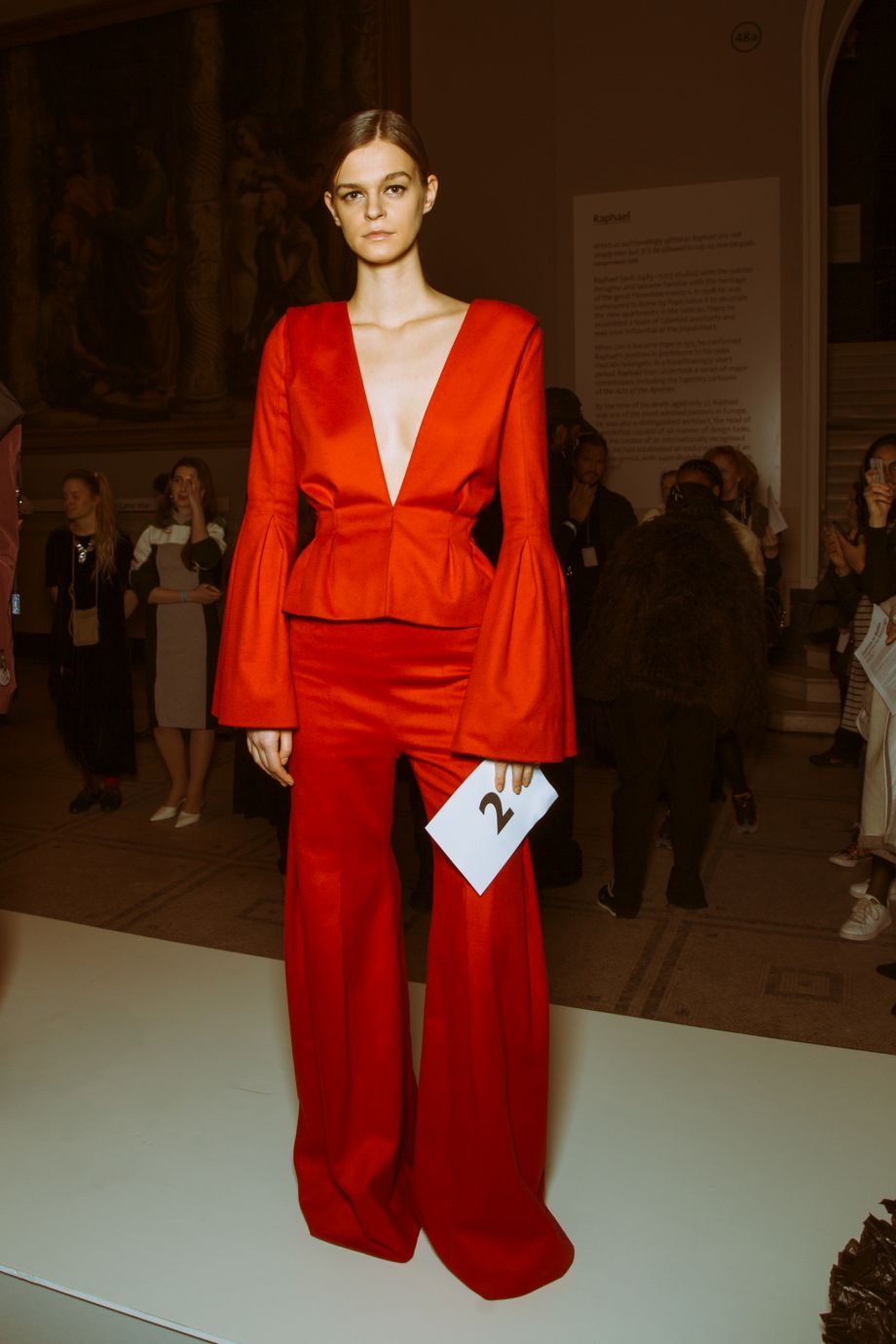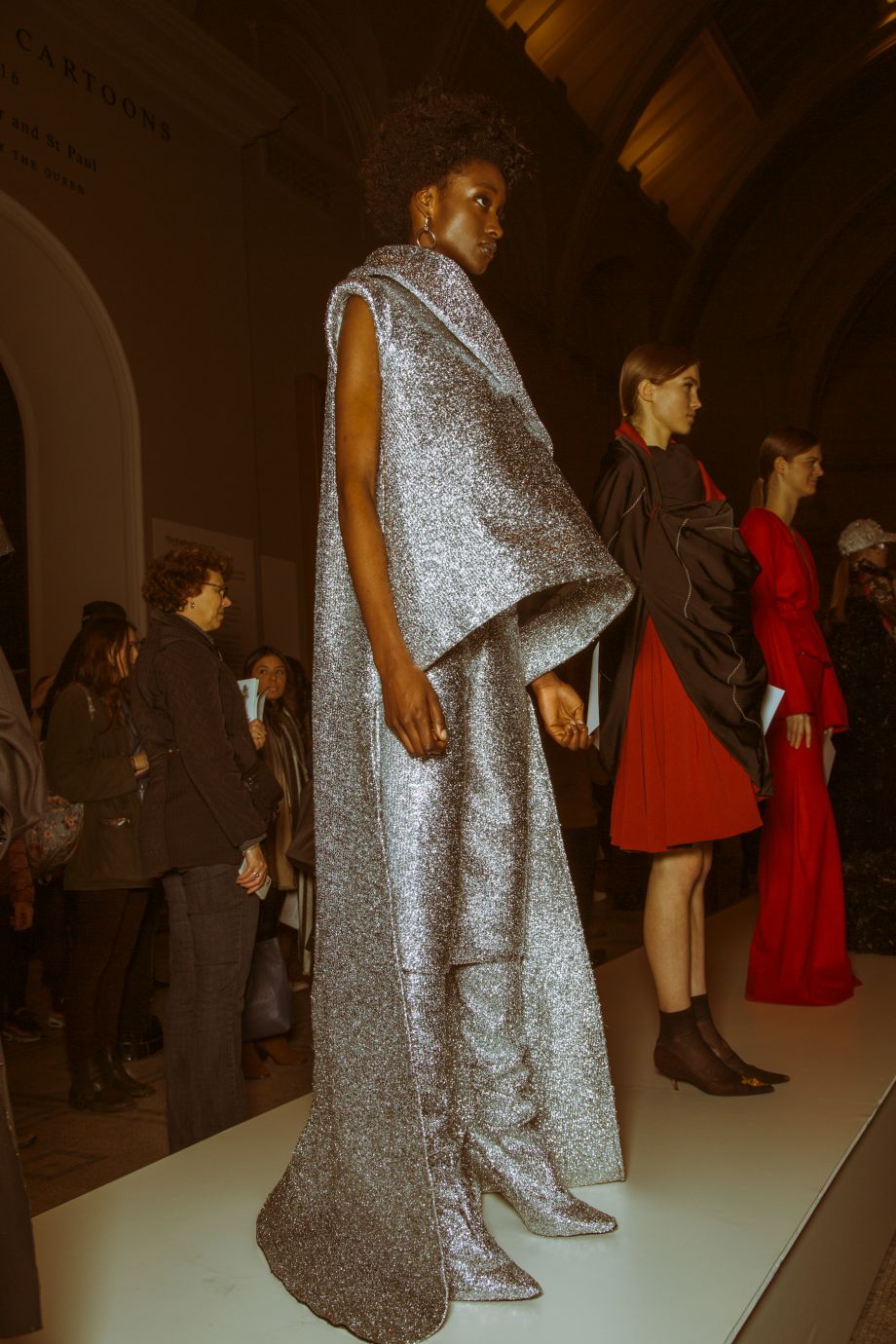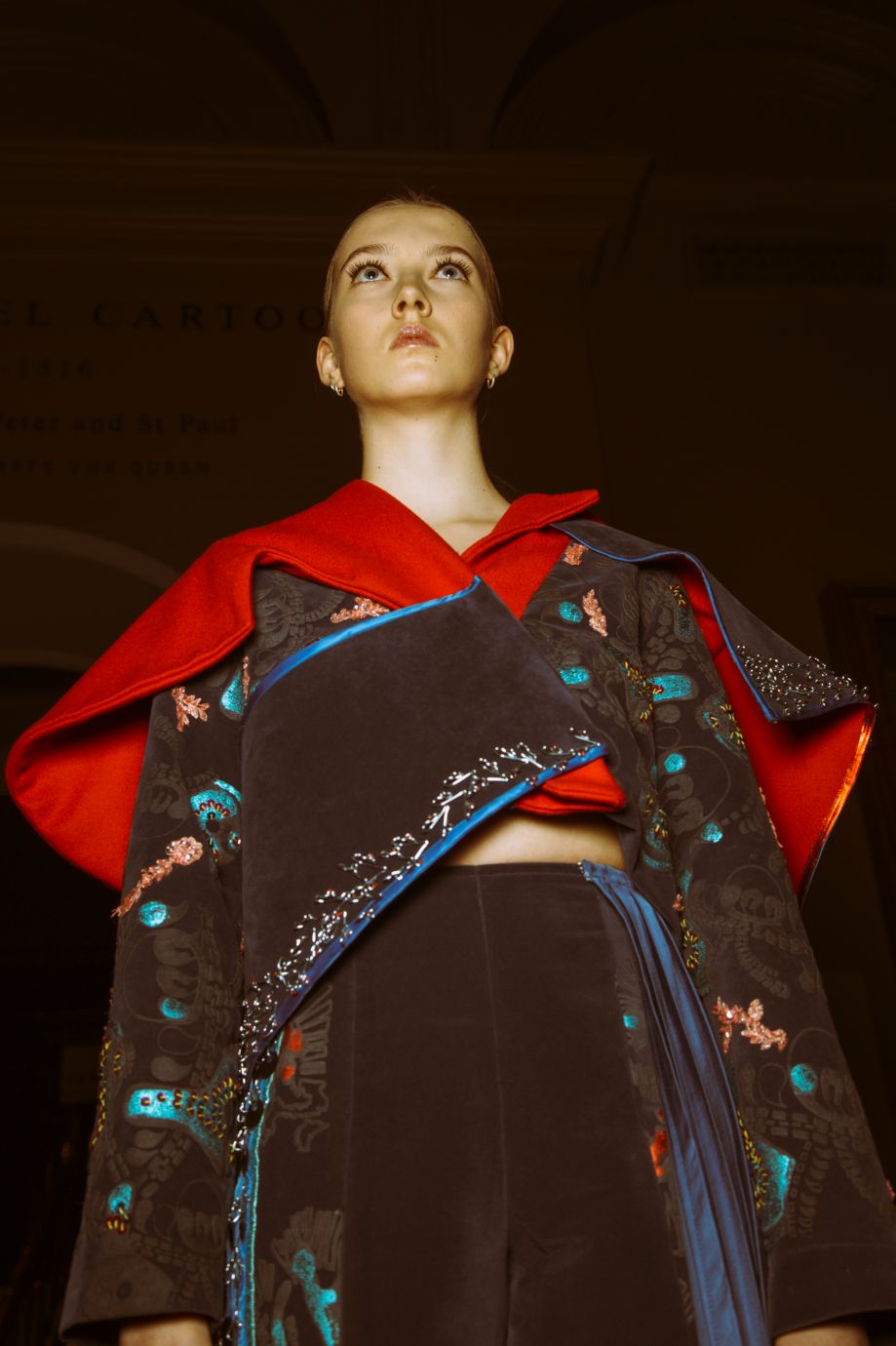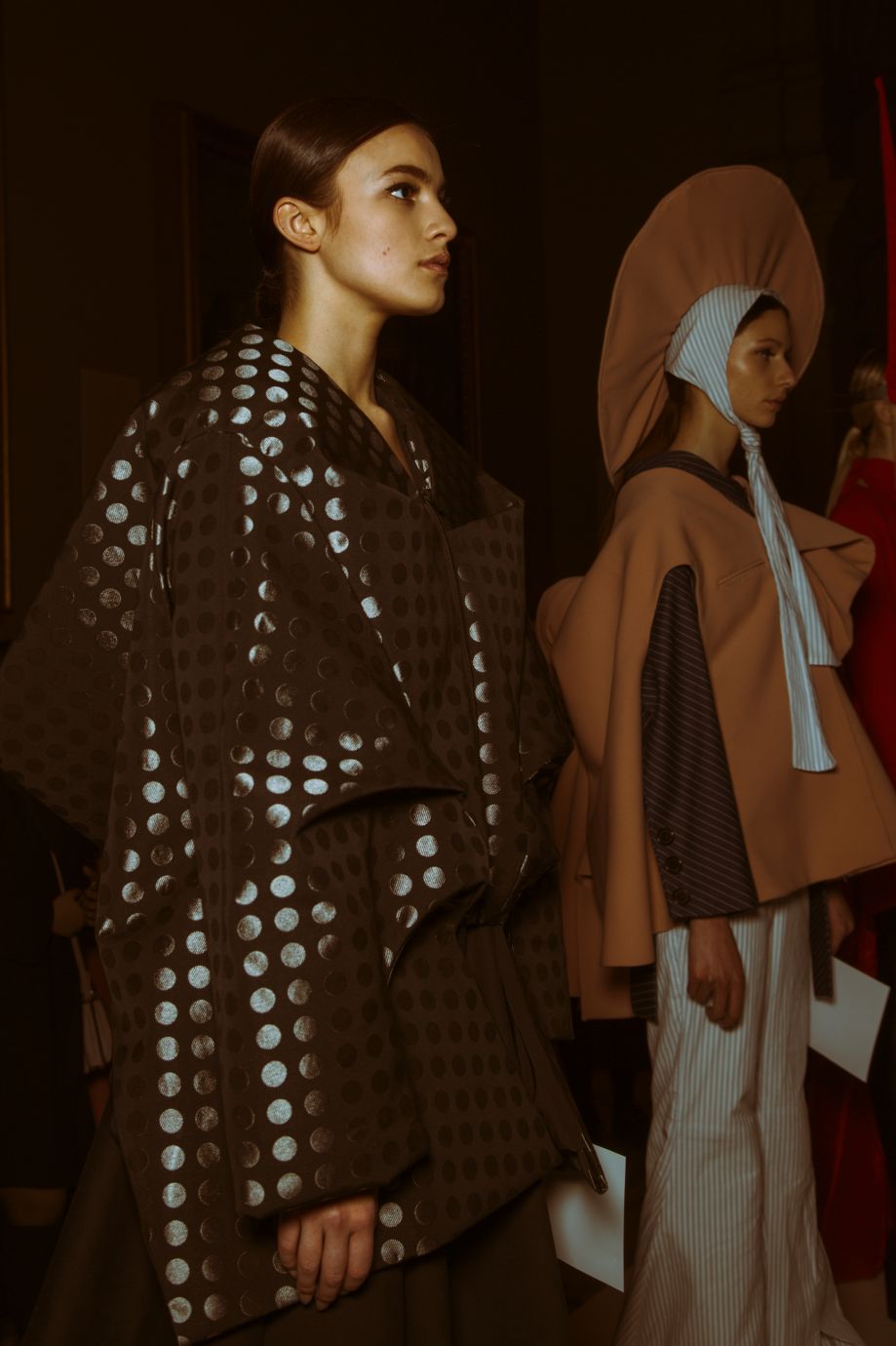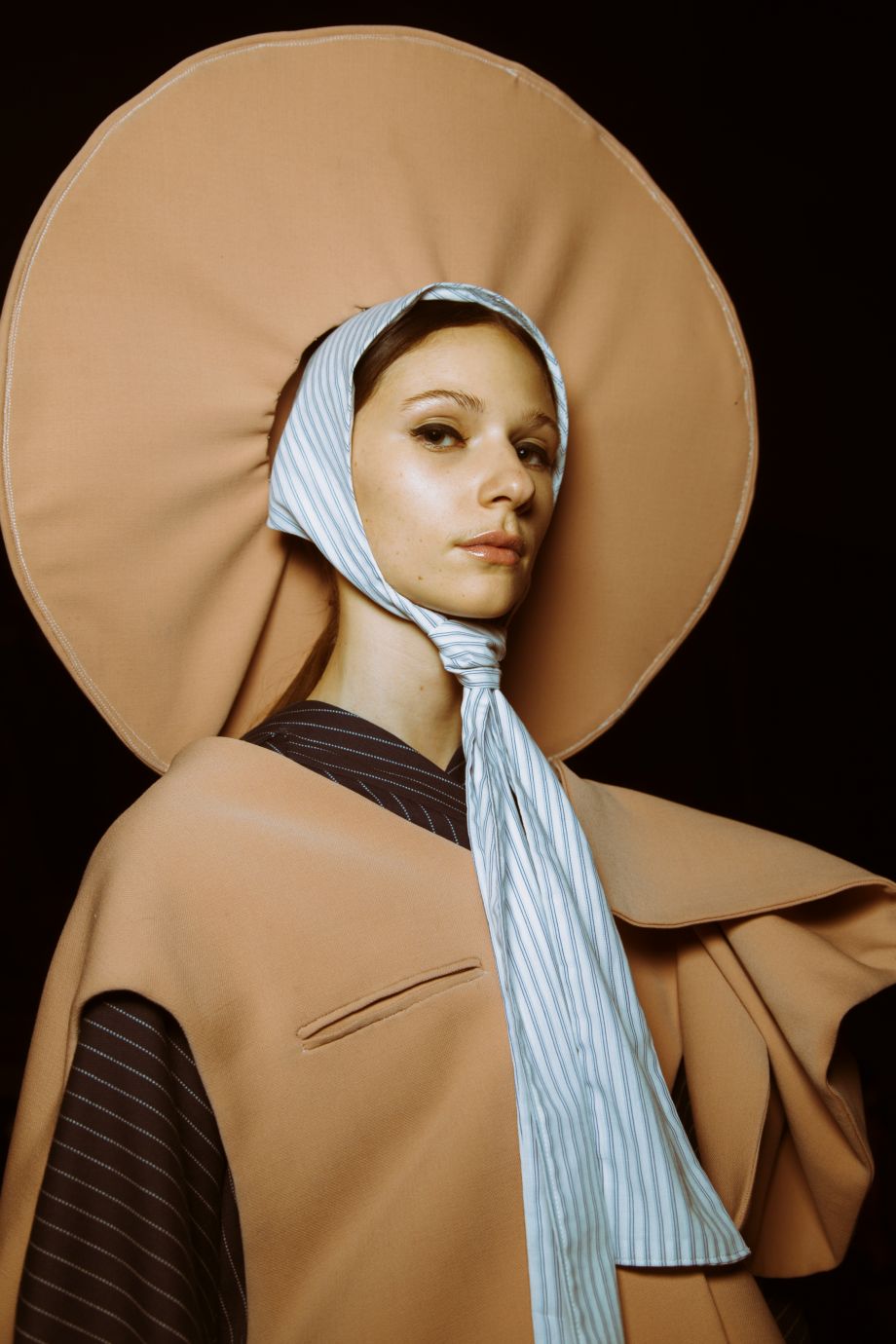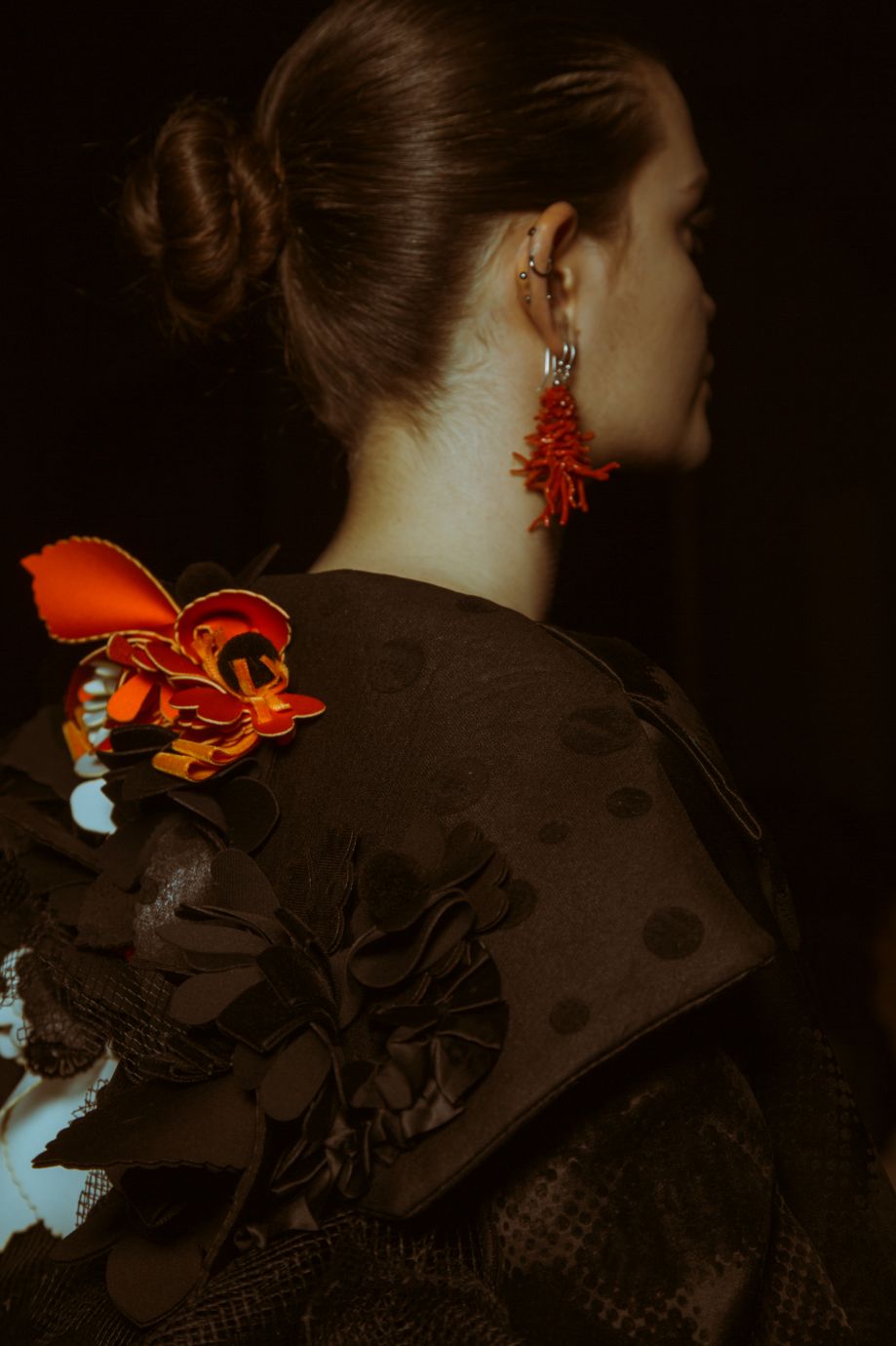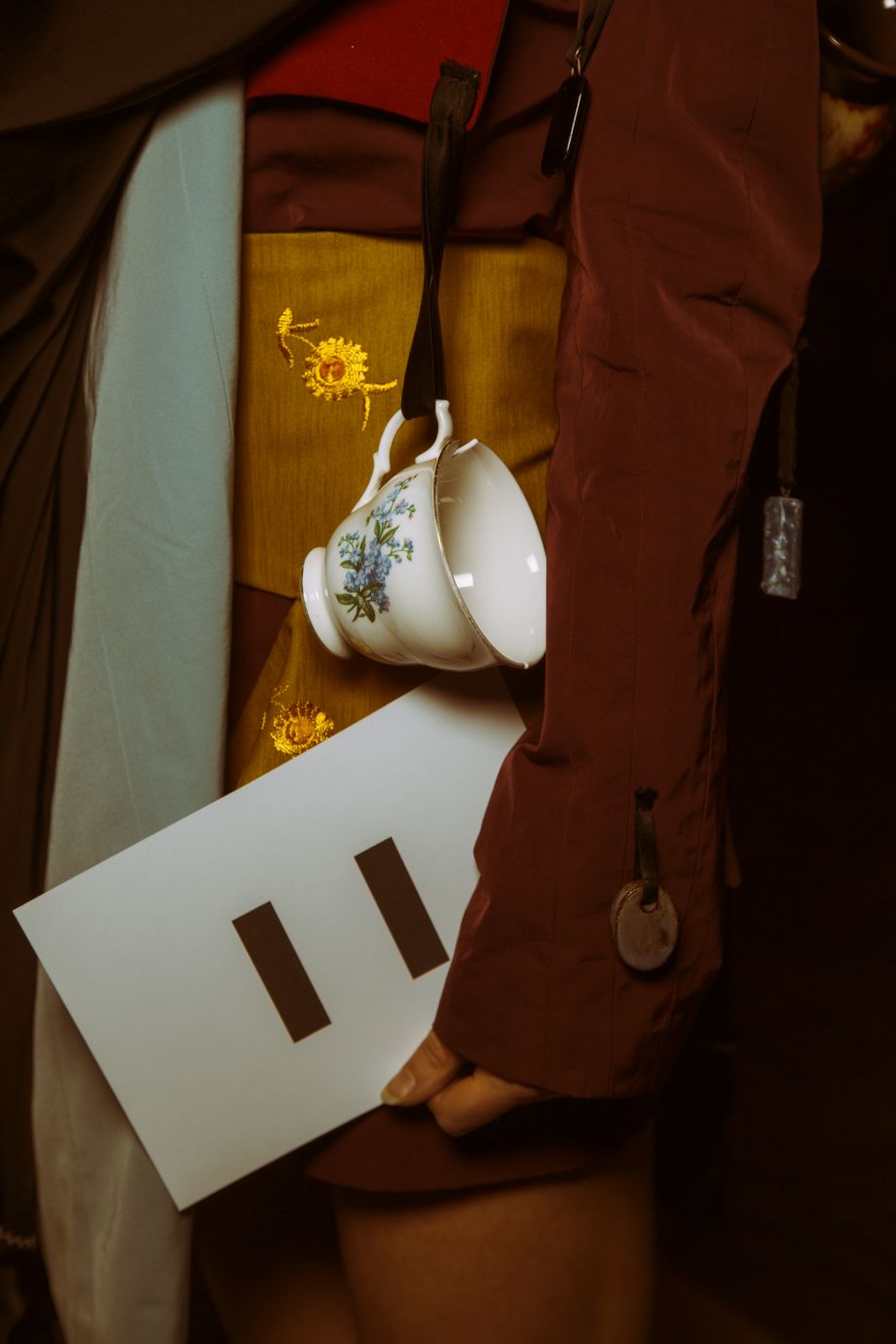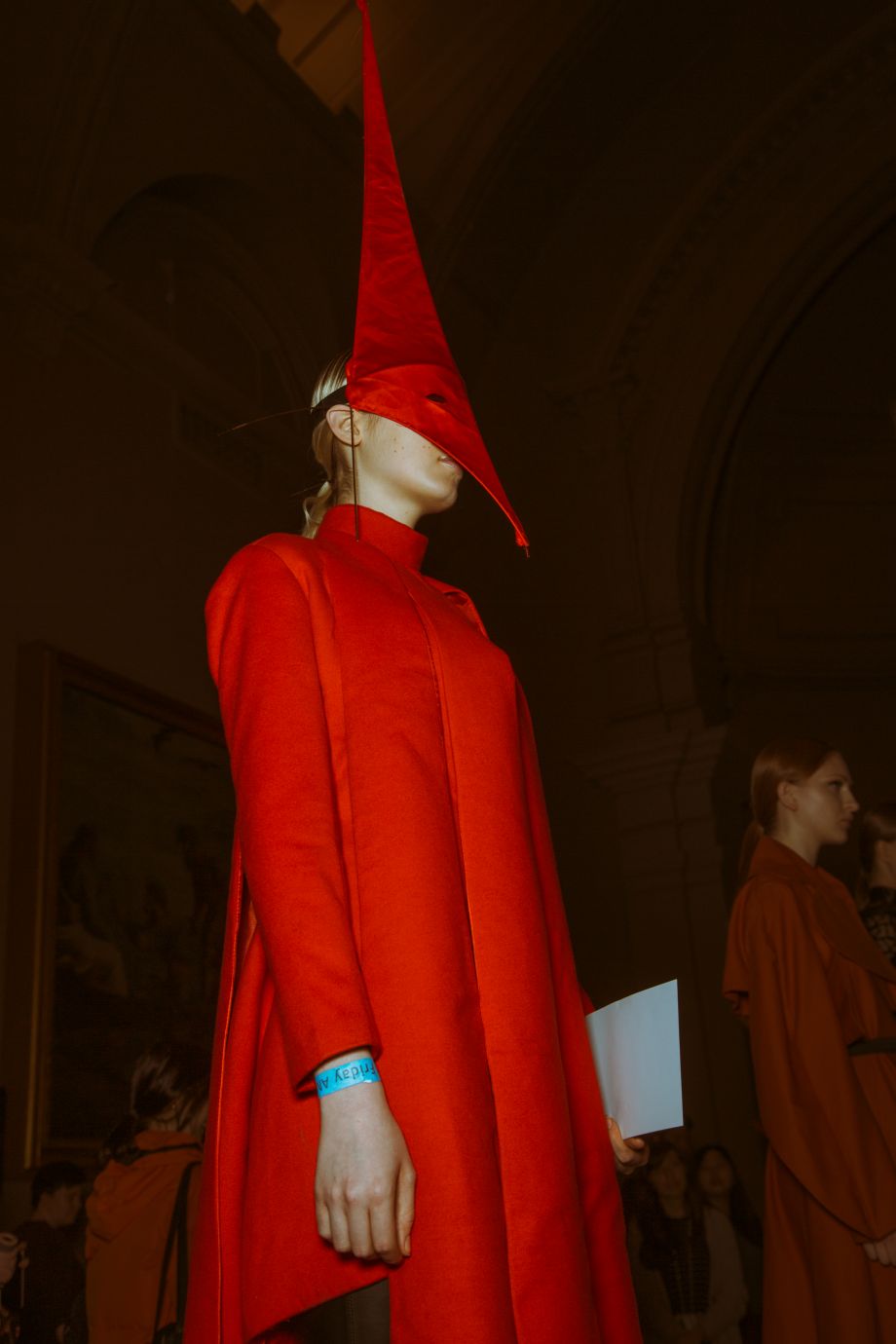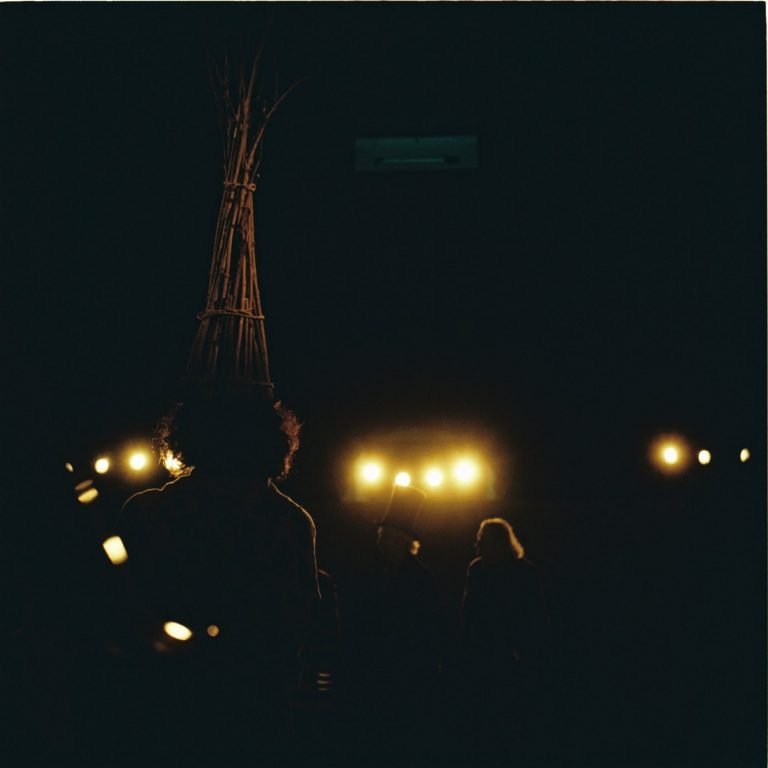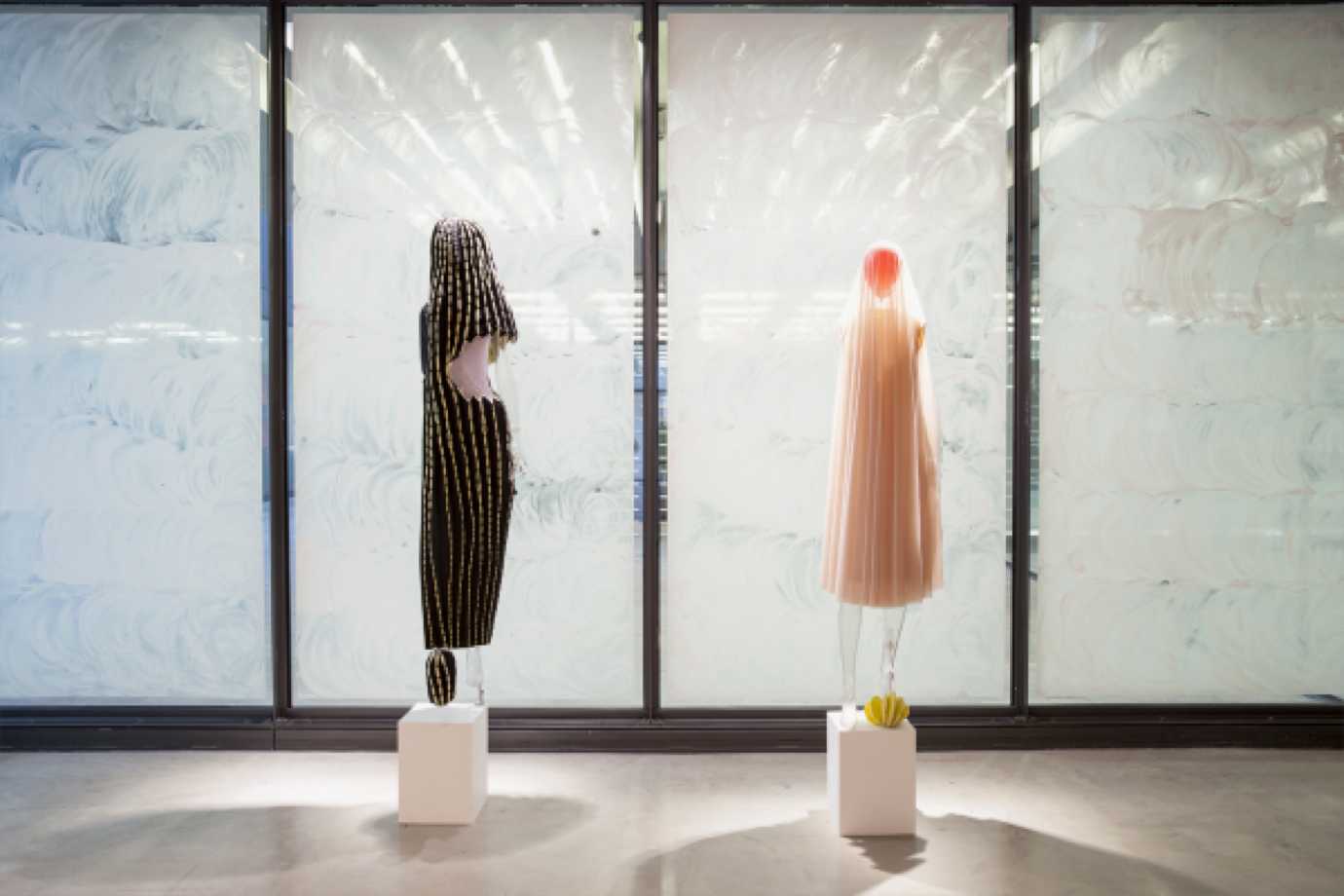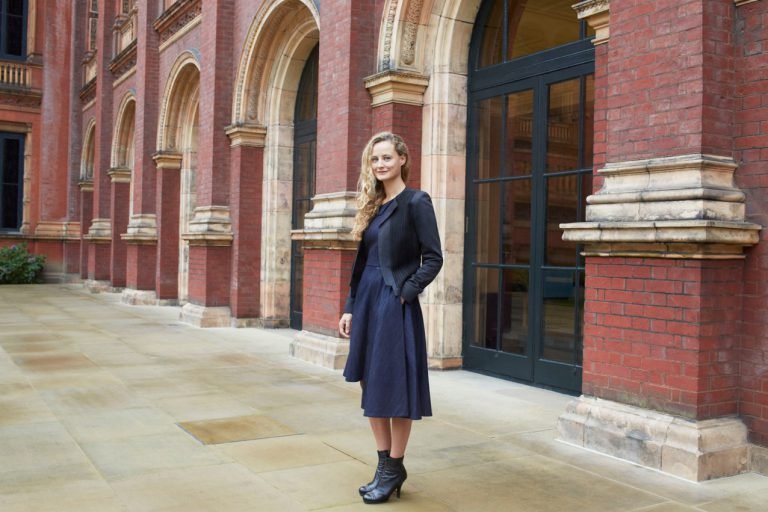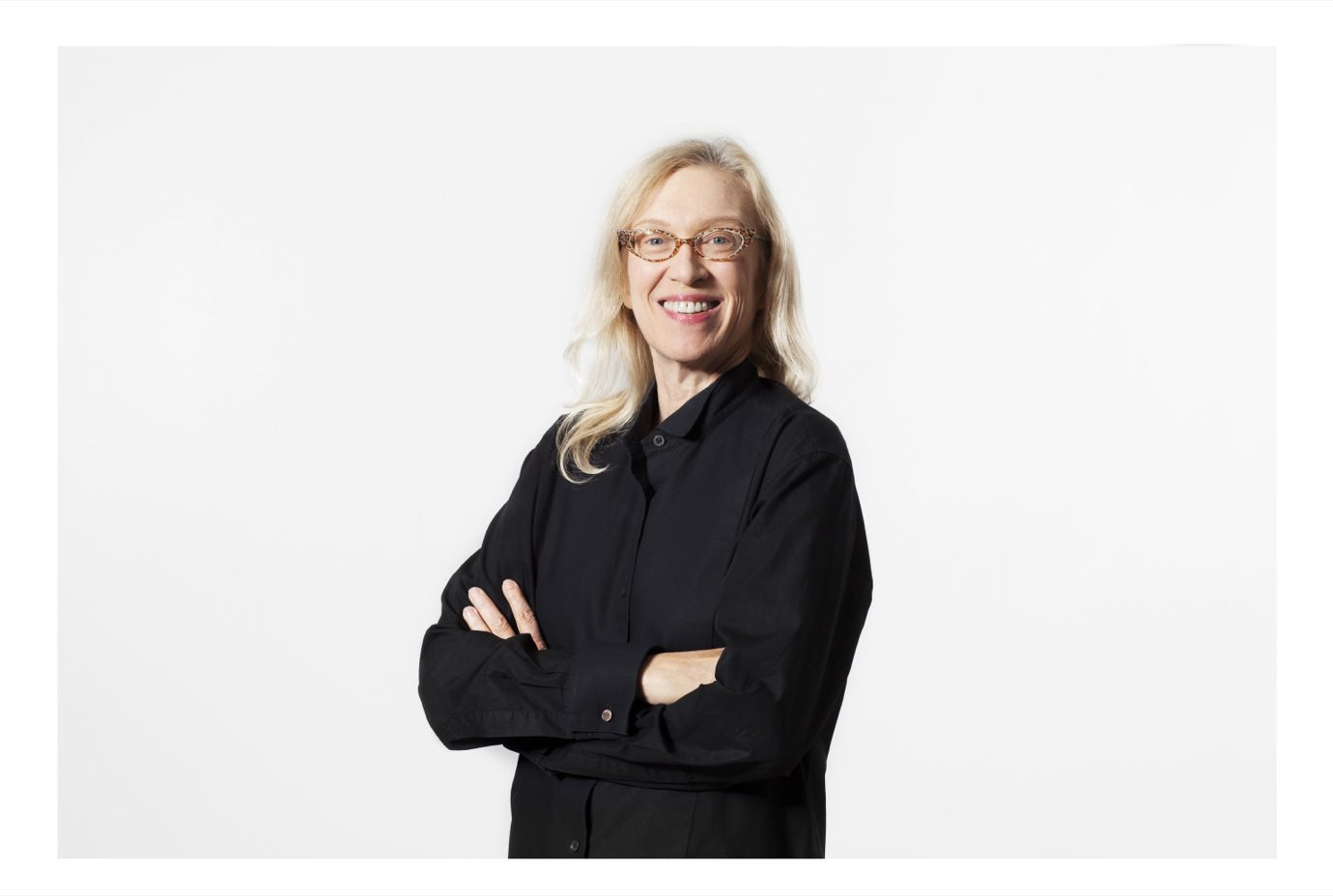If the true Balenciaga woman still exists today, she has survived through Daisy Yu’s model, wearing a fluid red ensemble, named ‘Elegant but risqué’. “In a way, it describes the woman I am designing for: someone who is powerful and bold, someone who isn’t afraid to show off their body, being all the while refined and tasteful,” she shares.
Solid fabrics and outstanding shapes, a striking reminiscence of Balenciaga’s designs, were unmissable. Past and present met on that evening, for sure, as CSM students brought back the parading atmosphere of Balenciaga’s ‘60s Parisian salon, making models carry numbered etiquettes. The brightness, if not an unusually subtler colour-blocking, called for the gaze to appreciate both refinement and elaborate constructions, from the embroidered flowers on mesh of look number 9 to the romantic porcelain cup hanging on garment number 11.
The current political climate surrounding immigration in the U.S. and around the globe did not miss the party. Zoe Zoberski designed her garment “as a physical reminder of what can happen when people let racist prejudices make decisions.“ Using several images of her great-grandfather who wore westernized tailored suits when living in America, she mixed these with traditional dress worn by Japanese women coming through the immigration station at Angel Island. She found inspiration as well in her great-grandmother’s wedding kimono. “I used the juxtaposition of themes to create a piece which strives to represent my family’s struggle of holding on to their culture while being forced to integrate into another,“ she develops.
Following the same path, Juan Lea Palomino based his design process on the place that he is from: “Peruvian women were forced to wear Spanish European clothes, so, in order not to lose their culture and traditions, they blended their culture with Spain,“ he starts. Gathering the past of Peru under colonisation as well as today’s remaining sigma, Juan named his project “la paisana,“ a black ensemble, whose jacket shapes the native Peruvian woman in the side view, while the polka dots remind of Cristobal Balenciaga’s bustier dresses in 1948. The exhibition “Alta Moda“ by Mario Testino was of great influence to his designs.
That hall was breathing Spanish majesty, a revisited austerity referencing the royal history impact on the greatest couturier of the 20th century; the look number 4 as a modern souvenir of that cassock that Balenciaga showcased in 1954, which was born from church’s dress inspiration. Juxtaposing contradictory atmospheres and shapes happened to be the starting-point for Rhianna Morton: “My design was drawn from the juxtaposition of the modern, elegant and very high class woman, mixed with the uniformity and structure from the working class fisherman.“ Balenciaga used to design for many upper class women, but he sourced his ideas from the working class. The silhouette explores this idea, emulating some of Balenciaga’s “more classic, simple, yet clever approach to design.“
Interestingly, the presentation did not happen in the antique sculptures hall. Unsurprisingly, Balenciaga fanatics used to be named the purists as his sculptural purity is seen adorning the woman’s body. Although the show was short, a graphic intensity exploded around the Raphael Gallery: so much to look at, details delighting sight in their most complex device. Hamish Bowles once mentioned that Balenciaga rejected bullfighting but absolutely loved the drama it offers. Impressive on one hand, intriguing on the other, CSM designs asked for interpretation.
“When I first saw Balenciaga’s designs, I thought he was boring; I thought his collections were just pretty dresses,“explains Hansol Kim, as he was not able to see the couturier’s pattern cutting up close. However, as soon as he was introduced to the Spanish master’s process by the curator of the Cristóbal Balenciaga exhibition in Bilbao – sleeves’ back patterns bigger than the front, seam reduction as much as possible without ruining his aesthetic – changed the CSM student’s mind, amazed and respectful of the couturier’s sculptural achievements. “He was crazy about volume, in my perspective at least!“, he says, “This idea lead my project: what is my way to make volumes nowadays?“ Focusing on providing his silhouette with volume through air, Hansol started his project with some parachute idea alongside minimalist tailoring pattern cutting.
Jamie Challinor was part of the team that looked into Balenciaga’s legacy as well. “My starting point was an essay I had done on depictions of sedated and passive masculinity in film.” Masculinity in marriage and the influence of the woman on a man living together formed his creative springboard. His granddad became the muse of the project; his and his wife’s house interior strongly influenced Jamie’s print design. All students had the chance to travel to Spain for a private view at the Balenciaga museum; there, Jamie got moved by the wool coats from the ‘60s, discovering the complex construction of Balenciaga’s simple and minimal looking pieces. His garment had to materialise such sophisticated simplicity. Using the technique of moulding directly on top of the mannequin to create the bell pattern, he then decided to explore it on the trousers as well. “I wanted to show the feminine influence on a man when they are married and exploring accentuated silhouettes of a woman on a man, incorporating it into traditional menswear, to illustrate this”, Jamie ends.
The main difficulty for the young creatives was “to keep things simple like Balenciaga. Where he was able to create garments that had such a strong impact with so few seams,“ Daisy revealed. Rhianna, as well, found herself overcomplicating the process and adding too many different elements to the concept: “I wanted to ensure that the design was enough ‘me’ but also enough ‘Balenciaga’.“
One question remains: did CSM students purely illustrate the Spanish master’s legacy, or experiment with contemporary creative director’s graphics? As wisely suggested by Rhianna: “It was more about the historic Balenciaga and tailoring; we were advised not to look too much, or even at all, into current Balenciaga. I think that was a good advise, as a lot of current Balenciaga draws from the original archives for shape and silhouette as it is,“ she completes.
One thing is sure, the students managed to perfectly transcribe the holy atmosphere that Balenciaga’s guests used to experience in the past, as Vogue Editor-in-chief at the time, Diana Vreeland, once put: “One fainted. It was possible to blow up and die. Everyone was going in foam and thunder.” If the master himself struggled to explain his metier to anyone, how could we? Let’s suppose that on this Friday night, a legendary designer joined contemporary populist fashion, reiterating historical references with a graphic grace ahead of its time. Like Balenciaga, the CSM BA fashion and print students remained unknown to the public; an ode perhaps to the mysterious aura that surrounded the most expensive couturier in Paris, who never appeared at the opening of his collections.


